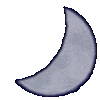|
The Circle of Light Issue #2 Date: 13/5/2001  In this issue: Editor's Note Articles: Daily Divination by Taliana WolfSpirit New Sections: Psychic Gifts: Astral Travelling Reviews Teen Witch and Spiritonline Book of Shadows Regular Sections: Animal Magick: Armadillo Bluebird Crystals by Apasi Gods and Goddesses of Witchcraft: Loki Brigit Jupiter Pagan Band Review Moving Breath Your Say: Submit Your Say Read What Others Say Submit Your Own Work      |
Jupiter Submitted by Ryan Bennington Information from various sources  Jupiter is of Roman root. In Latin his name means "Shining Father". The Eagle is his animal, as well as his messenger. The thunderbolt is his symbol, and white and blue are his colors. In alchemy, he is represented by tin. Other titles of Jupiter include: Description: Mythology: In the early Republican era, when Rome was an agricultural city, he first appeared as an agricultural god in charge of sun and moonlight (Jupiter Lucetius), wind, rain, storms, thunder and lightning (Jupiter Elicius), sowing (Jupiter Dapalis), creative forces (Jupiter Liber) and the boundary stones of fields (Jupiter Terminus). As Rome developed into a city of commerce and military force, Jupiter evolved into a protector of the city and state of Rome. As with his earlier agricultural form, he could be invoked through a variety of titles, each dependent on the responsibilities being requested of him: His main temple was the "Capitolim Vetus", situated on the Capitoline Hill in Rome, which he shared with Juno (his sister and consort) and Minerva, to form the Capitoline Triad. He also presided over the Roman games.He determined the course of human affairs and made known the future through signs in the heavens, the flight of birds etc. As Jupiter was lord of HEAVEN and bringer of light, white was the colour sacerd to him; hence among the alchemists Jupiter designated tin. In heraldry Jupiter stands for azure, the blue of the heavens. Astronomy: The Great Red Spot is a storm on Jupiter, big enough to hold two Earths. Other smaller but similar spots have been known for decades. Spots also appear on Saturn and Neptune. Jupiter has a very strong gravitational field and is very dense. When it is in the nighttime sky, Jupiter is either the 3rd or fourth brightest thing in the sky at night. Jupiter has 16 known satellites, the four large Galilean moons and 12 small ones. Jupiter is very gradually slowing down due to the tidal drag produced by the Galilean satellites. Also, the same tidal forces are changing the orbits of the moons, very slowly forcing them farther from Jupiter. Jupiter's satellites are named for other figures in the life of Zeus (mostly his lovers). Between Jupiter and Io are the moons Metis, Adrastea,Amalthea, and Thebe. Outside Callisto are Leda, Himalia, Lysithea, Elara, Ananke, Carma,Pasiphae, and Sinope. Rings: Halo,Main, Gossamer Our knowledge of the interior of Jupiter (and the other gas planets) is highly indirect and likely to remain so for some time. Astrology:  Email Ryan at: petrol-sunrise@portal.gs |
